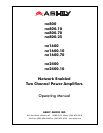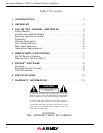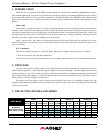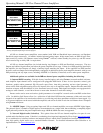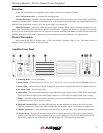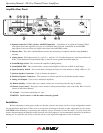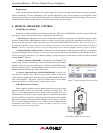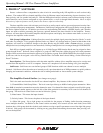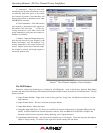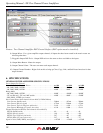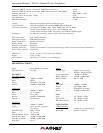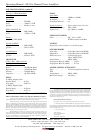
Operating Manual - NE Two Channel Power Amplifiers
8
5. PROTEA
ne
SOFTWARE
Protea
ne
software offers a comprehensive suite of tools for controlling Ashly NE amplifiers as well as other Ashly
products. The standard NE two channel amplifiers allow for Ethernet control and monitoring of power functions, level,
mute, polarity, and live speaker load analysis. With the DSP option installed, software control and monitoring of major
audio functions can be custom configured on a per channel basis, as well as through linked channels. More in-depth
discussion of software features can be found in the Protea
ne
software online help.
The base amplifier comes with software provisions for an audio control surface, password protected security func-
tions, and network property management. Furthermore, Link Group Configuration and Power On Delay are set up under
the Device Options menu tab. In addition, provisions for implementing DSP modes, AES/EBU Inputs, and CobraNet
inputs are made available, presuming the necessary optional hardware has been installed in the amplifier. Protea
ne
software will auto-detect the installed amplifier hardware options and display the resultant menu items as soon as it
recognizes the amplifier on the network.
Link Group Configuration - Linking allows the controls for multiple signal processing function “blocks” to track
each other. For example - if two graphic equalizer blocks are “linked”, any change made to a control within either of the
equalizers will result in an identical change to the other. Blocks may be linked within a Protea
ne
device, or across
multiple devices (assuming that devices are networked). Linking of multiple devices is managed through LINK GROUPS.
Each NE two channel amplifier will support up to 16 Link Groups. DSP function blocks may be assigned to these
groups though Protea
ne
Software. Once assigned to a group all LIKE functions within the group will track parameter
changes. However more than one function type may be assigned to a group. Each LINK GROUP may be assigned a name
by the user, and also be assigned a color for easy identification. For further details about linking, see the online help in
Protea
ne
Software.
Preset Options - The Preset Options tab in the main amplifier window allows amplifier setups to be saved to and
recalled from the amplifier as well as a computer. Presets are a snapshot of all current settings on a given amplifier.
Sub Presets - Sub Presets are user defined groups of DSP functions within one channel or across multiple
channels. Sub Presets allow the end user to instantly recall a pre-determined set of DSP parameters to quickly address
changing environmental conditions, without the risk of making undesirable or irrecoverable system changes.
The Amplifier Control Surface (see image next page)
This is the main user interface for the NE two channel amplifier. Key features of this window include:
1) Channel/Offset Link Group Faders - The level control provides up to 40dB of analog input attenuation. More
than 40dB of cumulative attenuation causes the channel to mute. If a channel has been assigned to an offset link group,
a colored triangular marker appears on the left side of the fader graticule for secondary level control of all channels in
that group. The main level control faders can not be linked to a group.
2) Mute button - This mutes the input channel.
3) Polarity button - This inverts the phase of the input channel.
4) Offset link group - Up to eight groups are available for the purpose of linking similar function parameters
across multiple channels. In addition to the control surface secondary level control (not the main fader), most DSP
functions have a link group check box in their work window to assign a specific parameter to one of the eight link groups
if desired. Link groups can be renamed by clicking on any group name and entering the new name then pressing <en-
ter> on the keyboard.



